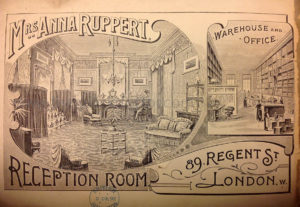Source: London Evening Post, December 27, 1755
The Dr Linden of the advert is Diederick Wessel Linden, a physician from Westphalia who came to Britain in 1747 and settled in Flintshire. Better known for his writings about spa waters, and for featuring in an amusingly earthy scene in Smollett’s Humphry Clinker, he deserves a post of his own at some point, so today I’m just going to do a round-up of a few unusual remedies for gout.

Should you be planning to ‘indulge in rich meats and sauces, racy wines, strong beer and cyder, and use but little exercise’ this Christmas, it might be worth keeping some of the following treatments handy:
In 1680, Sir William Temple, Bart, had published his experiments with the ancient Eastern practice of moxibustion (applying a small quantity of mugwort to the skin and setting it alight). This was still in print at the time of the above ad, though more as an historical curiosity than a source of advice:
Upon the first burning, I found the skin shrink all round the place ; and whether the greater pain of the fire had taken away the sense of a smaller or no, I could not tell ; but I thought it less than it was: I burnt it the second time, and upon it observed the skin about it to shrink, and the swelling to flat yet more than at first.
On the third burning, he was able to set his foot down without pain, but tended the burns by applying a clove of garlic and a Diapalma plaster. Temple also recounted some interesting remedies he had heard about on his travels, such as that recommended by Prince Maurice of Nassau:
…to boil a good quantity of horse-dung from a stone horse of the Hermelinne colour, as he called it in French, which is a native white, with a sort of a raw nose, and the same commonly about the eyes : that, when this was well boiled in water, he set his leg in a pail-full of it, as hot as he could well endure it, renewing it as it grew cool for above an hour together ; that, after it, he drew his leg immediately into a warm bed, to continue the perspiration as long as he could, and never failed of being cured.
A surgeon in Lorrain, meanwhile,
had undertaken to cure it by a more extraordinary way than any of these, which was by whipping the naked part with a great rod of nettles till it grew all over blistered;
(An alternative to nettles was holly – is that what’s happening to the Jolly Huntsman in the gallery?)

In the mid 18th century, one of the free books given away by Mr Burchell of Anodyne Necklace and Sugar Plums for Worms fame intriguingly offered:
‘The Easy Way of Curing the GOUT, by Transplantation: that is, By giving it to some Good-for-Nothing DOG, or CAT, and thereby Freeing the Person from it.’
(Transplantation didn’t mean anything surgical, you just had to get the dog or cat to lie on your feet.)
A poetical correspondent to The Morning Post and Daily Advertiser on Christmas Day 1786, however, put forward a different view. Though beginning with an agonised ‘Hence, loathed Gout! most dreaded fiend to Ease,’ he weighed up the pros and cons of the lifestyle that had led to his condition, and concluded:
But what is life, without or love or wine,
Without the orgies of the mystic bowl?
Let moralists their mental joys define,
But sweeter far the midnight flow of soul.
Gout! Then attack – I’ll brave thy greatest ill,
And fall, like valiant BEVILL, on the topmost hill.
.
Wishing you all a very happy and gout-free Christmas!




Another fascinating post!
Happy Christmas to you to!
Elliott
Goodness, it doesn’t look very ethereal!
Fabulous post, as always. Thank you, it is always such a treat to visit and read and learn.
Have a wonderful, wonderful holiday!